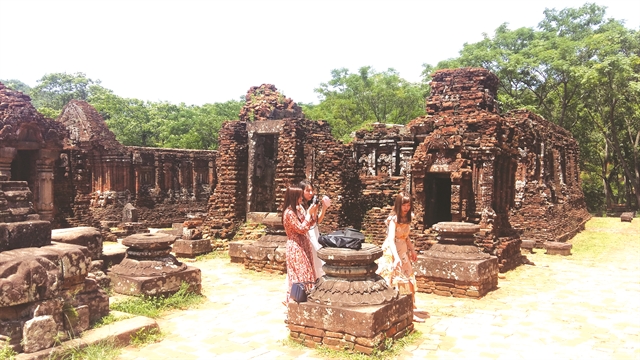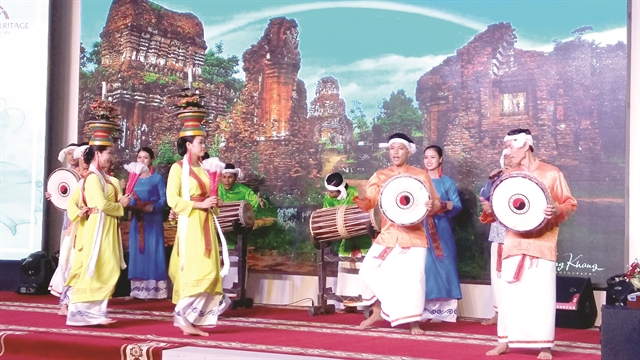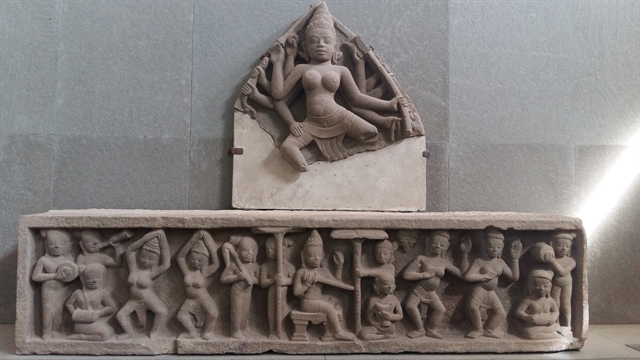
Ancient: A ruined Chăm tower preserved at Mỹ Sơn Sanctuary in Quảng Nam Province. The UNESCO-recognised world heritage site has 70 towers and temples that were built by the Chăm people between the 4th and 13th century. VNS Photo Công Thành
Situated in a peaceful valley surrounded by mountains, the Mỹ Sơn Sanctuary – a UNESCO-recognised world heritage site in Quảng Nam Province’s Duy Xuyên District – has been well preserved since it was built thousands of years ago during the prosperous development of the Champa Kingdom between the 4th and 13th centuries. The ruins are now a popular destination because of their cultural relevance and architectural features.
Hồ Xuân Tịnh, who researched Chăm culture during his 20-year career in culture management in Quảng Nam, describes the Mỹ Sơn Sanctuary – including 70 Chăm towers and temples – as the most unique complex of intricate architecture and sculpture of Chăm culture in central Việt Nam.
The Mỹ Sơn Sanctuary was where royal families of the Champa Kingdom celebrated religious ceremonies and put kings to rest, according to Tịnh.

Historic: Tourists pass a complex of collapsed Chăm towers in Mỹ Sơn Sanctuary. The site is a popular destination for foreign tourists in Quảng Nam. VNS Photo Công Thành
Tịnh said the temple and tower complex was protected by a high mountain range and a stream from the Thu Bồn River (A major river system in central Việt Nam).

Cultural: Artists perform a traditional dance of the Chăm at Mỹ Sơn Sanctuary. The Champa Kingdom ruled the central region between the 4th and 13th century. VNS Photo Công Thành
“Historically, the mountain range was a safe shelter for liberation fighters during the American war in the 1960s, and the US air force failed to hit the military base of resistance movement due to the difficult terrain,” Tịnh said.
“Although many bombs did not hit the target, many brick temples and towers either collapsed or were partly damaged,” Tịnh said, adding that time and weather also damaged the remains of the Mỹ Sơn Sanctuary.
“At least 70 temples and towers had been built from the 4th century, and brick and natural cement were used,” he said.

Working together: Local workers restore a Chăm tower following a project at the Mỹ Sơn site. Different projects have been organised between Việt Nam, Poland, Italy, India and UNESCO in preserving the complex. VNS Photo Công Thành
Research into the construction techniques of the Chăm people resulted from the restoration of monuments in 2003-13 by the Việt Nam-Italy-UNESCO tripartite partnership.
The project yielded significant results including the successful restoration of Group G monuments, standard documentation of archaeological research, and archaeological excavations of artefacts for public display.
The project, at a total cost of over US$1.6 million and funded by the Italian Government, paves the way for a study of brick making skills of the Chăm and as an example of conservation and protection of Chăm towers throughout the country.
Nguyễn Công Khiết, deputy head of the Mỹ Sơn Sanctuary management board, said the research into brick production helped fill in the holes on collapsed Chăm towers.
He said local craftsmen spent time baking clay bricks in wood-fired kilns.
“Bricks had to be not too hard, but not too soft. Every brick must be laid with natural resin in the middle. We tried to apply techniques used by Chăm people thousands of years ago,” Khiết said.
“Resin from certain trees was used as adhesive material to create strong, and waterproof, brick structures. There are resins extracted from the tree Dipterocarpus alatus – one of the most popular natural adhesive used by fishermen in making boats in central Việt Nam,” he explained.
Varadaras Suresh, an Indian expert, who has been working on the restoration of towers in Groups K, A and H, said resin was mixed with powder to create an adhesive.

Intricate: A sandstone sculpture on display at a museum. Art works were often found in excavations of Chăm towers in central Việt Nam. VNS Photo Công Thành
“The ancient Chăm people used resin as a special ‘glue’ to fix bricks so they would stand the test of time,” Suresh said.
“Resin, which was easily found in tropical forests, is a waterproof material,” he said.
“A lot of work has been done since we came here to restore a tower in Group H. Land clearance and protective brick work has been done to keep the tower strong through the rainy season,” he added.
“We rebuilt the towers following the original design, including the order of every brick. Only damaged or missing bricks were replaced with new ones. The Chăm people were very accurate, so we could not change the position of every brick,” he said.
Conservation
The director of the management board of the Mỹ Sơn Sanctuary, Phan Hộ, said Polish archaeologist and architect Kazimierz Kwiatkowski, known as ‘Kazik’, contributed to the recognition of the Sanctuary as a world heritage site by UNESCO in 1999.
Kazik and a group of Polish archaeologists had strengthened ruined towers with cement, as well as clearing groups of towers in 1981-95 before they would be damaged due to weather and poor conservation.
The towers in Group B were then restored by a group of Polish architects in the 1980s.
Polish architect Kazik had lived in Việt Nam for 16 years to help restore major structures in the ancient town of Hội An, the Mỹ Sơn Sanctuary and the Complex of Huế Monuments (the three sites were recognised as world heritage by UNESCO), of which two belong to Quảng Nam.
Italian archaeologists then continued the restoration of Group G on the site from 1997 before Indian experts began recovering towers of Groups K, A and H from 2017-21.
A long time earlier, French archaeologists and researchers found the Mỹ Sơn Sanctuary in 1885, and the first excavation and research on the Chăm towers began in 1898-99 by Louis Finot and Launet de Lajongquere.
Heri Parmentier researched the site in 1901-02, and many artefacts were brought to the Chăm Sculpture Museum in Đà Nẵng City.
The Mỹ Sơn Sanctuary management board has called for international co-operation and investment in excavation and restoration of F1, F2, D1, D2 towers and Group A in creating further value of the ancient complex.
Cultural researcher Tịnh said the Mỹ Sơn Sanctuary is still a unique and mysterious archaeological site, and it remains a research centre for Chăm culture – a defunct civilization in Asia. – VNS
OVietnam